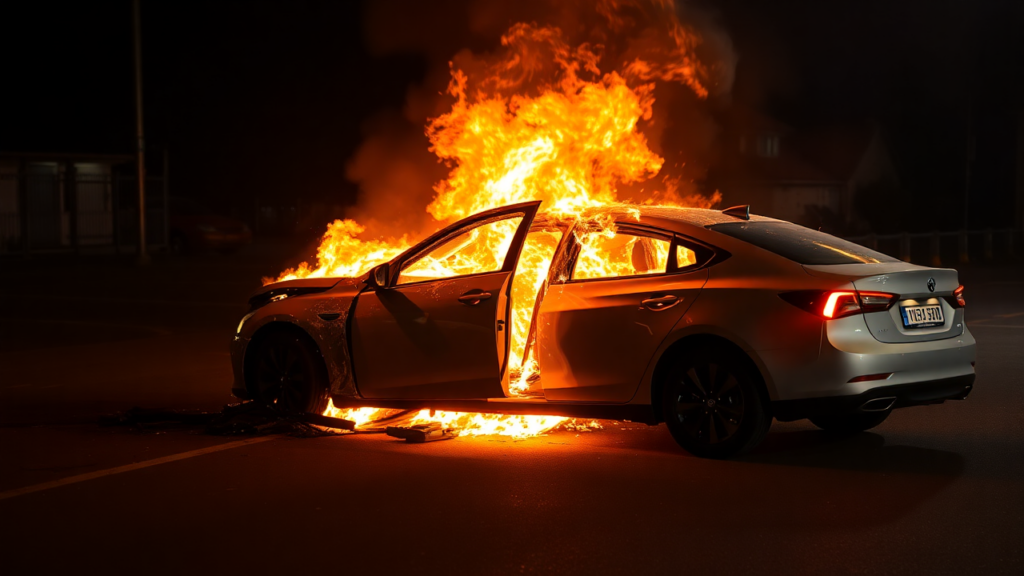A tragic wrong-way driving accident on Highway 4 in Brentwood Wednesday night, May 21st, claimed two lives and shut down both directions of the highway for over seven hours, raising essential questions about electric vehicle battery fires and hazardous material response protocols.

The Deadly Crash: What Happened on Highway 4
The fatal accident occurred around 10 p.m. Wednesday between Balfour and Marsh Creek roads. According to the California Highway Patrol, one vehicle traveled in the wrong direction when it collided head-on with another. Both drivers were pronounced dead at the scene.
The collision’s impact was severe enough to cause significant damage to both vehicles, but the involvement of an electric vehicle created additional complications that extended the emergency response time considerably.
The force of the head-on impact at highway speeds likely left little chance for survival for either driver. Highway 4 is a major thoroughfare connecting the East Bay to the Central Valley, and crashes at this location often involve high-speed travel.
The California Highway Patrol is investigating the wrong-way driver’s path and the circumstances that led to traveling against traffic. Authorities are working to piece together the events that preceded this devastating collision.
Electric Vehicle Battery Fire Creates Hazmat Emergency
One of the vehicles involved in the crash was an electric vehicle whose battery pack burst into flames upon impact. This development transformed what would have been a standard fatal accident response into a complex hazardous materials situation requiring specialized equipment and personnel.
A hazmat team from Lafayette was called to the scene to handle the electric vehicle battery fire. The response team was required to monitor for toxic fluoride gas emissions released when electric vehicle batteries burn.
Electric vehicle battery fires burn at extremely high temperatures and can reignite hours or even days after appearing to be extinguished, making them particularly challenging for emergency responders.
Lithium-ion battery fires require specialized suppression agents and continuous monitoring, unlike conventional vehicle fires that can be quickly suppressed with water or foam. The batteries can also release large amounts of toxic smoke that pose immediate health risks to anyone nearby, necessitating evacuation of the surrounding area and specialized air quality monitoring throughout the incident.
The Hidden Dangers of Electric Vehicle Battery Fires
Electric vehicle battery fires present unique challenges that differ significantly from traditional ones. The Contra Costa County Fire Battalion Chief explained at the scene, “The batteries release a gas that leaches the calcium out of your bones.”
This toxic fluoride gas poses serious health risks to first responders and anyone near the fire. The gas can cause:
- Calcium depletion from bones
- Respiratory complications
- Chemical burns to exposed skin
- Long-term health effects of prolonged exposure
These risks require specialized protective equipment and extended response times, as traditional firefighting methods are often inadequate for electric vehicle battery fires.
Beyond the immediate health hazards, electric vehicle battery fires can continue burning for hours. They may require thousands of gallons of water to extinguish fully, significantly more than conventional vehicle fires. Depending on wind conditions, the toxic smoke plume can travel considerable distances, potentially affecting nearby residents and businesses.
Fire departments nationwide increasingly invest in specialized training and equipment to handle these incidents. The growing number of electric vehicles on roadways means such emergencies are becoming more common than exceptional occurrences.
Highway Closure and Traffic Impact
The severity of the crash and the hazmat response necessitated the complete closure of Highway 4 in both directions for over seven hours. The highway remained closed from approximately 10 p.m. Wednesday until 5:20 a.m. Thursday morning.
This extended closure significantly impacted commuter traffic and highlighted the implications of accidents involving alternative fuel vehicles on major transportation corridors.
The closure forced thousands of commuters to seek alternate routes during late evening hours and the critical morning rush. Local roads in Brentwood, Antioch, and surrounding communities experienced heavy congestion as drivers were diverted from the main highway.
The California Department of Transportation worked closely with local authorities to establish detour routes. Still, the nearly seven-and-a-half-hour closure demonstrated how incidents involving electric vehicles can have far-reaching economic and logistical consequences beyond the immediate crash site.
Legal Implications of Wrong-Way Driving Accidents
Wrong-way driving accidents, like the one that occurred on Highway 4, raise complex legal questions about liability and responsibility.
Accident attorneys typically investigate factors such as driver impairment from alcohol or drugs, medical emergencies that may have contributed to wrong-way travel, road design and signage adequacy, lighting conditions and visibility factors, and vehicle mechanical failures. Each of these elements can significantly impact the determination of fault and the potential for recovery in civil litigation.
The families of victims in wrong-way driving accidents may be entitled to compensation through various legal avenues, including wrongful death claims and insurance settlements, particularly when negligence or other contributing factors can be established through a thorough investigation and expert analysis.
Emergency Response Protocols for Electric Vehicle Accidents
This incident underscores the need for enhanced emergency response protocols for electric vehicle accidents. First responders must be equipped with:
- Specialized protective equipment for toxic gas exposure
- Training on electric vehicle fire suppression techniques
- Hazmat response capabilities
- Extended response time planning for battery fire incidents
The Brentwood incident also highlights the importance of interagency coordination when dealing with electric vehicle emergencies. Local fire departments must work closely with hazmat teams, highway patrol, and environmental agencies to ensure proper containment and cleanup of toxic materials.
Many emergency response agencies are now developing specific protocols that include pre-positioning specialized equipment along major highways with high electric vehicle traffic, establishing mutual aid agreements for hazmat response, and creating real-time communication systems to identify when electric vehicles are involved in accidents quickly.
Preventing Wrong-Way Driving Accidents
While this accident involved unique complications due to the electric vehicle fire, the underlying cause was wrong-way driving. Prevention strategies include:
- Enhanced roadway signage and lighting
- Driver education about impairment risks
- Technology solutions like wrong-way detection systems
- Regular road maintenance to ensure clear lane markings
Statistics show that wrong-way driving accidents are more likely to occur during nighttime hours and weekends, often involving impaired drivers or those experiencing medical emergencies. Highway 4, like many major thoroughfares, sees increased risk during periods of reduced visibility and higher speeds.
Transportation authorities are increasingly implementing advanced warning systems, including LED road signs that activate when sensors detect wrong-way movement and improved highway design features such as raised pavement markers and reflective barriers that make it more difficult for drivers to enter highways in the wrong direction inadvertently.
What Families Should Know After Fatal Accidents
Families affected by fatal traffic accidents face not only emotional trauma but also complex legal and financial challenges. Understanding your rights and options is crucial during this difficult time.
Fatal car accident settlement calculators serve as valuable tools to help families understand the potential compensation they may be entitled to following a wrongful death. These calculators consider multiple factors, including the deceased’s age, income, earning potential, medical expenses, funeral costs, and the emotional impact on surviving family members.
While these online tools provide helpful preliminary estimates by analyzing economic losses such as lost wages and benefits over the victim’s expected lifetime, they cannot fully account for the unique circumstances of each case or the intangible losses like pain and suffering, loss of companionship, and emotional distress.
Professional legal evaluation remains essential for accurate settlement assessment. Call us now at +1 415-986-4777 to talk to the experts.
Moving Forward
“Tragedies like the Highway 4 collision remind us how quickly lives can be forever changed by someone else’s negligent actions,” says Andy Gillin, founding partner at GJEL Accident Attorneys. “While nothing can bring back a loved one or undo the pain of a serious injury, families shouldn’t have to face the financial burden alone when someone else’s wrongful conduct is to blame. If you’ve lost a family member or been injured in an accident involving wrong-way driving, electric vehicle fires, or any form of negligence, you have rights that deserve protection. Don’t let insurance companies minimize your claim or pressure you into accepting less than you deserve during this vulnerable time.”- Andy Gillin, GJEL Accident Attorney
If you or your family has been affected by a serious traffic accident, especially one involving wrongful death, consulting with experienced accident attorneys can help protect your interests and ensure you receive the compensation you deserve.
The tragic loss of life in this Highway 4 collision serves as a reminder of the importance of safe driving practices and the evolving challenges that new vehicle technologies present to emergency responders and the legal system alike.
If you or a loved one were injured in the Stockton pedestrian accident, don’t face the aftermath alone. Our experienced team at GJEL Accident Attorneys understands the physical, emotional, and financial challenges you’re experiencing.
We’re ready to evaluate your case, explain your rights, and fight for the compensation you deserve—all while you focus on recovery. Contact us today for a free, no-obligation consultation. Remember, we only get paid when you do. Call +1 415-986-4777 or visit our Orinda office to protect your future.
Additional Resources and Information
Local Authorities and Traffic Information
Brentwood Police Department
- Address: 9080 Brentwood Blvd, Brentwood, CA 94513
- Non-Emergency Phone: (925) 809-7911
- Emergency: 911
- Website: City of Brentwood Police Services
- Traffic accident reports and records can be requested through the Records Division.
California Highway Patrol – Martinez Area Office
- Address: 30 Muir Station Rd, Martinez, CA 94553
- Phone: (925) 646-4980
- CHP Traffic Incident Information System: CHP Traffic Incidents
- Online accident report requests: CHP Online Services
Contra Costa County Sheriff’s Office
- Address: 1980 Muir Rd, Martinez, CA 94553
- Phone: (925) 646-2441
- Traffic Services Division handles major traffic investigations
- Website: Contra Costa County Sheriff
California Department of Transportation (Caltrans) District 4
- Phone: 1-800-427-7623 (1-800-GAS-ROAD)
- Highway conditions and closures: QuickMap
- Traffic alerts and construction updates
- Incident reporting for road hazards
If you need assistance obtaining police reports, traffic incident documentation, or have questions about legal proceedings following a traffic accident, these agencies can provide official records and information necessary for insurance claims and legal actions.

